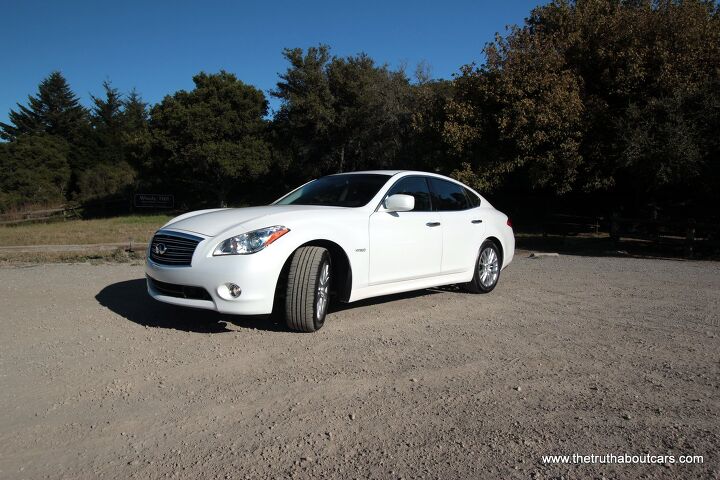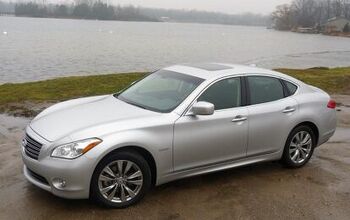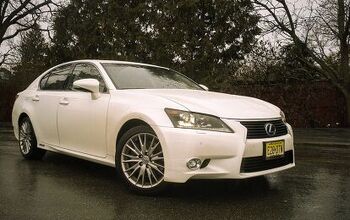Review: 2012 Infiniti M35h Hybrid

Let’s face it, hybrids are boring. They are slow, complicated, come with hard tires and soft suspensions, sloppy handling, and they look weird. We’ve heard the story before: this hybrid is different. First Lexus gave us the GS and RX hybrids claiming V8 performance with V6 fuel economy, but the result was more like V6 performance with V6 economy, not really a great sales pitch. Still, hybrids sell well and with Infiniti marching towards mainstream luxury success they “need” a hybrid. Of course, with Infiniti aiming to be the “Japanese BMW”, performance is obviously a prime concern, so the claim from Infiniti that the M35h will deliver “V8 performance and four-cylinder economy” was expected. But is it another case of leather clad disappointment? Let’s find out.
Not too long ago Infiniti dropped off a new M56x at my doorstep, at that time I didn’t much care for the styling, commenting: “Every time I approached the car I felt as if an enormous box-fish was going to devour me.” While the Infiniti M still looks hungry to me, seeing more of them on the road has perhaps warmed me up to the design and I find the form more attractive than before. As we often point out on TTAC, style is terribly subjective and subject to our own personal leanings, so take my opinion with a grain of salt if you like the look. My informal lunch group’s opinions were mixed with some loving the flowing curves and some preferring sharp creases in their sheet metal alá Cadillac and Mercedes.
Inside the M35h (and much like the M56x) there is little to find fault with. But there is also little to identify this M as the hybrid that saves the world and your testosterone. The only change to the well put together cabin for hybrid duty is the charge/power gauge in the cluster replacing the engine temperature gauge found on other M models. The center stack, nav system and trim are all the same (with the hybrid specific software teaks of course) and there are no blue back-lit hybrid badges, EV mode buttons, or displays with growing leaves to be found. This is the sleeper hybrid if there ever was one.
The lack of hybrid bling does not mean the M35h lacks tech, quite the contrary. The M35h gets the same suite of standard and optional gadgets as the base M37, not a bad list to pull from. The 7-inch standard infotainment screen does everything but navigation, iPod and USB integration with Bluetooth speakerphone is standard as is the 6-speaker Infiniti auto system with a single in dash CD player and XM satellite radio. Opting for the $3,350 “premium package” gets you Infiniti’s easy to use navigation system with a high-resolution 8-inch display, Bose 5.1 channel surround sound system with speakers in the seat backs, voice controlled functions, heated steering wheel and cooled front thrones and active cabin nose canceling.
Should you desire the latest in driving nannies, Infiniti is happy to oblige with radar cruise control, collision warning and prevention, lane departure warning and prevention and an accelerator pedal that fights back. The accelerator pedal is perhaps the nanny that people will find the most fault with, especially if you are an aggressive driver. The feature can of course be turned off, but if dialed up to full-on German-au-pair, it will fight you hard, forcing the pedal back at you if you’re driving uneconomically or if it thinks you are getting too close to a car, or if it feels like it needs to stop the car NOW. While I dislike the thought of a car that drives for me, honestly at least half the drivers on the road need this pedal stat. Not that we condone distracted driving, but if you needed to, this car could help you accomplish the feat more safely.
The hybrid system is where the M35h departs from the regular M or the hither-to-normal hybrid. Until recently if you bought a hybrid in North America, you had one of three systems. Honda’s weak-sauce Integrated Motor Assist system just puts a motor between the engine and transmission and is essentially a start/stop system with some extra oomph. GM/BMW/Mercedes developed a crazy-expensive and crazy-complex 2-mode hybrid system which seems to be dying a slow death in the market [Ed: until CAFE rescued the investment]. And lastly we have the original true hybrid system, the Toyota/Ford system which uses a planetary gearbox to allow the engine, motor or both to drive the vehicle. Infiniti took a different approach to “hybridification” by removing the torque converter from a regular 7-speed automatic transmission and in its place stuffing a slim electric motor with two clutch packs (similar to the Hyundai/Kia hybrid system). These clutch packs are what make the Infiniti system innovative and different from the Honda IMA system.
Starting at the front of the car and working your way back, you first find a Nissan 3.5L V6 engine running on the Atkinson cycle (like most hybrids) putting out 302HP and 258lb-ft of twist. After the engine sits a dry clutch pack that allows the engine to start and run while decoupled from the electric motor. Next up we have a 360V AC motor that’s good for 67HP and 199lb-ft directly coupled to the Nissan 7-speed automatic transmission. Located inside the rear of the transmission is a wet clutch pack that allows the engine and motor to be connected with one another to charge the batteries with the vehicle stationary (it also slips to help make gear changes smoother). Decoupling the V6 reduces mechanical losses boosting the electric drive efficiency; this is an area where Honda’s system suffers. Behind the rear seats a 1.4kW lithium-ion battery, wedged where you’d put the 5th bag of golf clubs (Infiniti says a quartet of golfers can still be accommodated and they kindly print a diagram in the trunk to tell you how to manage it). And the final change is a tall 2.6:1 final drive ratio allowing the V6 to spin leisurely on the freeway (1,600RPM at 60MPH).
Hybrid systems like Toyota’s Hybrid Synergy Drive combine the motor and engine numbers in a way that is not simple addition (google is you must know why), however Infiniti’s system is easy to figure: the peak number is achieved where the HP and torque curves of the engine and motor meet, making the M35h good for a combined 360HP at 6,500RPM and approximately 410lb-ft at 5200RPM. Note: Our combined torque number is an estimate as Infniti does not officially list a combined rating; the “online” 457lb-ft numbers floating around are not accurate according to Infiniti because when the V6’s 258lb-ft peak does not align with the motor’s 199lb-ft peak.
The high torque of the electric motor from very low RPMs make the M35h far faster than the numbers on paper would imply, we easily recorded 5.2 second runs to 60MPH with our lowest taking only 5.03 seconds. The low 1.9 second sprint to 30MPH (the M56 takes 2.3) is perhaps the most telling number because by the time the spedo crested 100 the M35h had lost its lead on the V8 powered M56 clocking a 13.5 second ¼ mile at 103MPH (vs 13.4 at 106 for the V8). Part of the reason the performance is so good is the weight gain, at only 276lbs heavier than the M37, the M35h manages to be 99-lbs heavier than the M56 and slips in just below the AWD M56x on the scales. (The Lexus GS450h is only five pounds heavier.) Stoplight racers be warned however, that after a few 0-60 runs the battery and motor heat up enough that the control circuitry puts the kibosh on at least a portion of the electric assist and by the 6th back-to-back 0-60 run our times had risen to 6.2 seconds.
If you drive the M35h on a normal commute and not a track day, the EPA claims you’ll achieve 27MPG city, 32 highway and 29 combined. In our 7 days and 820 miles with the M35h we averaged a quite respectable 29.1MPG (excluding our track adventures, photo shoots, etc) in our mixed driving of mostly California freeway and rural mountain highway. Our numbers were no doubt buoyed by moderate traffic and a general inability to exceed 72MPH on the highways in the SF Bay Area. Infiniti claims the system will allow you to drive electric only up to 62MPH but in reality there didn’t seem to be much of an upper limit for the EV functionality provided you were gentle on the go-pedal. This is also a key area where the M35h differs from a Prius, to drive at 65MPH, the Prius has to use the engine because of the design of the transmission, the M35h on the other hand just disconnects the engine from the equation. While on a level highway with the cruise control set to 67MPH the hybrid system would switch in and out of electric only mode fairly often with my daily commute spending some 19% of the time in “EV mode” (22% for the lifetime of the car) as figured by the trip computer.
Since the M37 delivered some 22MPG on the same commute, the efficiency gain is noticeable. Thankfully hypermiling skills were not required to achieve our test numbers, but perhaps more strangely a daily jaunt testing all the hypermiling skills from Prius forums didn’t appreciably bump the numbers either. Since Infiniti opted to keep the grippy all-season tires from the non-hybrid M, and thanks to the nearly perfect weight balance, it was possible to test the economy figures on some of my favorite mountain roads. When driven this way the economy certainly drops like a rock (17MPG for that trip), which may sound bad, but put in perspective the lighter G37 convertible scored 11MPG on the same route.
What’s the M35h’s competition? By my estimation it competes most directly with the Lexus GS450h, a sedan that is not long for this world. Since the 2013 GS450h has yet to be announced officially, a comparison to the current hybrid GS is all I can offer. In this match up the GS offers a suitably swish cabin that has aged well but is a definite step behind the M35h’s silver-dist rubbed goodness (the 2013 GS I was able to preview at Pebble Beach has a competitive cabin, but is not a substantial step above the M35h). The GS is also significantly behind the M when it comes to fuel sipping delivering only 22/25/23 (city/highway/combined) EPA numbers, a substantial 26% lower than the 27/32/29MPG numbers Infiniti scored. If that weren’t enough of a shot across the bow of the company known for their hybrid tech, the M also wears a 20% smaller CO2 footprint, if you care about that sort of thing. Driving pleasure in the GS is limited by the CVT that is the heart of the Lexus Hybrid Sybergy Drive system, but that may be balanced out by the M35’s less polished transitions between gasoline and electric power.
With a base price undercutting Lexus by $5,250 and offering more interior room, a real transmisison and improved economy I’d take the M35h over the GS450 any day. Unfortunately like most hybrid cars the M35h has less of a value proposition when compared to its own non-hybrid brethren. The M37 which is cheaper, delivers 8/10ths the speed, 8/10ths the fuel economy and perhaps 11/10ths the luxury feel due to the sometimes quirky nature of the hybrid clutch packs the M35h uses. At the end of the day the M35h is far from a leather clad disappointment like other luxury hybrids, but as long as the M37 is available for sale, I just don’t see the M35h enjoying a place in my garage.
Not a fan of our Facebook page? Too bad. For out Facebook peeps, here’s what you wanted to know: Jason M: Smugness level is similar to a Prius, 1/2 the economy but 2X the car. Andy A: No paddle shifters. Clay C. I tried, but BlendTech doesn’t carry a car-sized blender. Phillip W: We never reached battery depletion levels, try as we might. This is easier in Toyota hybrids because putting the car in N disconnects the generator, the M will still connect the generator whenever it feels like it, N or not. Mirko R: Yes. Marc C: Mileage depends greatly on how you drive, we did however average 29.1 which is the combined EPA number in mixed driving, moderate speeds, moderate acceleration. Sergio P: No idea what the batteries will sell for, my dealer didn’t know either. J S: Not quite sure why Autoblog thought it was more refined than the Lexus system. Infiniti’s solution is perhaps more interesting, and it is newer, but it isn’t as smooth. Given the choice, I’d take the Infiniti.
Infiniti provided the vehicle for our review, insurance and one tank of gas.
Specifications as tested

More by Alex L. Dykes
Latest Car Reviews
Read moreLatest Product Reviews
Read moreRecent Comments
- SCE to AUX Norway is in Europe, and Tesla is an American automaker - no problems there.I wouldn't use Ford as the bellwether.https://www.reuters.com/business/autos-transportation/tesla-extends-lead-norway-evs-take-record-82-market-share-2024-01-02/https://elbil.no/english/norwegian-ev-policy/
- Steve Biro If the U.S. government wants to talk about banning all connected cars - or at least the collection and sharing of information from said vehicles - I’m all ears. Otherwise, don’t waste my time.
- Ajla Both parties are in favor of banning Chinese vehicles so I don't see how it won't happen in the next year.
- Add Lightness I don't waste a lot of time watching nothing much happening by watching the YouTube 6 minute highlights.
- MrIcky from my rental fleet experience, id rather drive one of these than a camry.



































































Comments
Join the conversation
"...Note: Our combined torque number is an estimate as Infniti does not officially list a combined rating; the “online” 457lb-ft numbers floating around are not accurate according to Infiniti because when the V6′s 258lb-ft peak does not align with the motor’s 199lb-ft peak..." Because when the V6's 258lb-ft peak does not align with the motor's 199lb-ft peak...what? Did I miss the last part of the statement?
Alex, It looks like you were in my neighborhood. Is that Windy Hill?